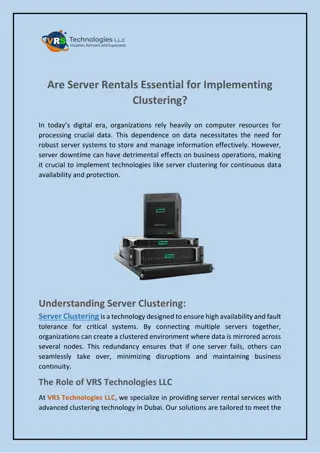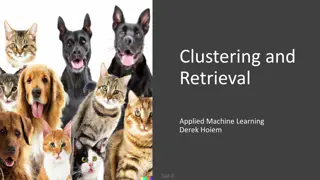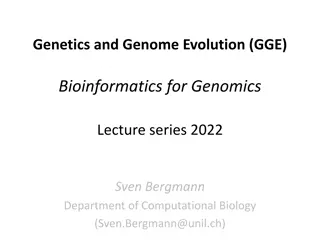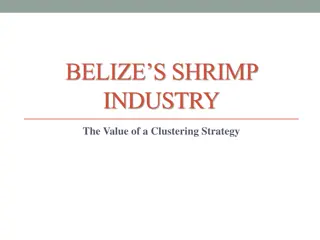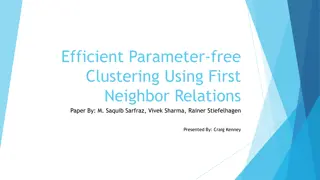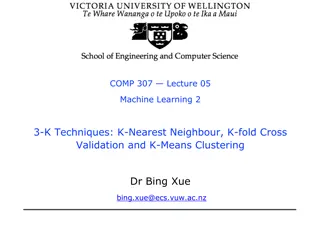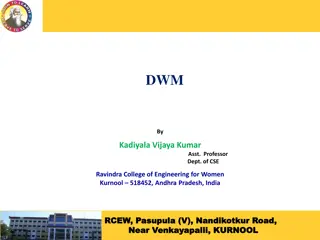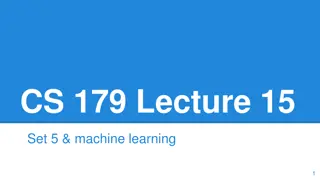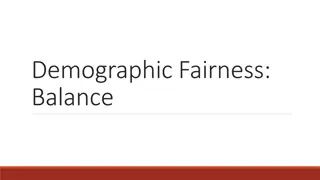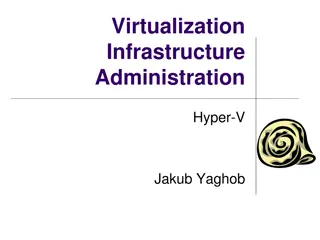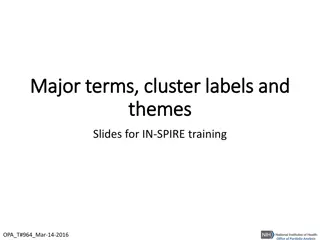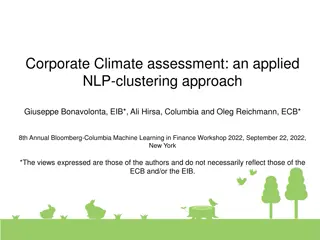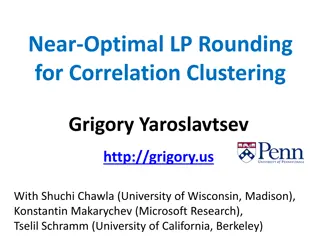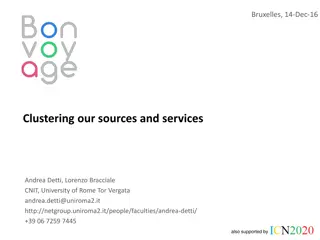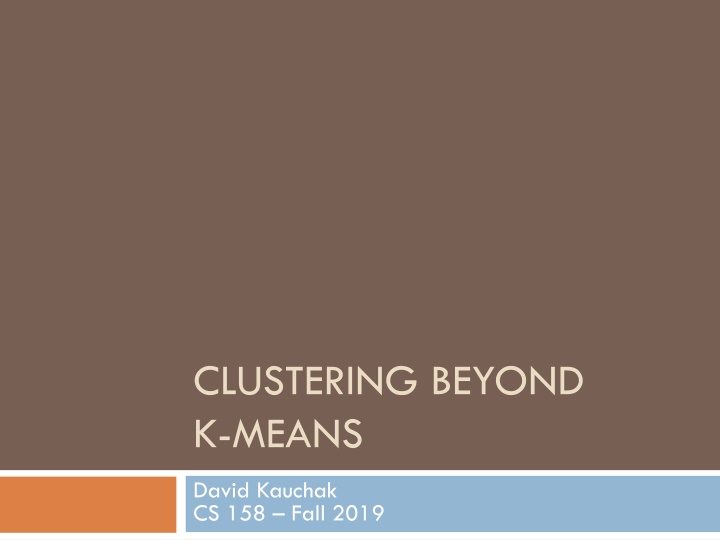
Advanced Clustering Techniques: Beyond K-means and EM Clustering
Explore advanced clustering techniques beyond K-means, such as EM Clustering, to address the limitations of traditional algorithms. Discover how EM Clustering handles data with ellipsoidal clusters and utilizes soft clustering methods for improved accuracy and flexibility in cluster assignments.
Download Presentation

Please find below an Image/Link to download the presentation.
The content on the website is provided AS IS for your information and personal use only. It may not be sold, licensed, or shared on other websites without obtaining consent from the author. If you encounter any issues during the download, it is possible that the publisher has removed the file from their server.
You are allowed to download the files provided on this website for personal or commercial use, subject to the condition that they are used lawfully. All files are the property of their respective owners.
The content on the website is provided AS IS for your information and personal use only. It may not be sold, licensed, or shared on other websites without obtaining consent from the author.
E N D
Presentation Transcript
CLUSTERING BEYOND K-MEANS David Kauchak CS 158 Fall 2019
Administrative Assignment 8 back Final project Status reports due tomorrow (can use late days) Presentations on Tuesday 4 minute max 2-3 slides. E-mail me by noon on Tuesday What problem you tackled and results Paper and final code submitted on Wednesday Next class: skim the papers
K-means Start with some initial cluster centers Iterate: Assign/cluster each example to closest center Recalculate centers as the mean of the points in a cluster
Problems with K-means Determining K is challenging Hard clustering isn t always right Assumes clusters are spherical Greedy approach
Problems with K-means What would K-means give us here?
Assumes spherical clusters k-means assumes spherical clusters!
K-means: readjust centers Iteratively learning a collection of spherical clusters
EM clustering: mixtures of Gaussians Assume data came from a mixture of Gaussians (elliptical data), assign data to cluster with a certain probability (soft clustering) EM k-means
EM clustering Very similar at a high-level to K-means Iterate between assigning points and recalculating cluster centers Two main differences between K-means and EM clustering: 1. We assume elliptical clusters (instead of spherical) 2. It is a soft clustering algorithm
Soft clustering p(red) = 0.8 p(blue) = 0.2 p(red) = 0.9 p(blue) = 0.1
EM clustering Start with some initial cluster centers Iterate: - soft assign points to each cluster Calculate: p( c| x) the probability of each point belonging to each cluster - recalculate the cluster centers Calculate new cluster parameters, c maximum likelihood cluster centers given the current soft clustering
EM example Start with some initial cluster centers Figure from Chris Bishop
Step 1: soft cluster points Which points belong to which clusters (soft)? Figure from Chris Bishop
Step 1: soft cluster points Notice it s a soft (probabilistic) assignment Figure from Chris Bishop
Step 2: recalculate centers What do the new centers look like? Figure from Chris Bishop
Step 2: recalculate centers Cluster centers get a weighted contribution from points Figure from Chris Bishop
keep iterating Figure from Chris Bishop
Model: mixture of Gaussians How do you define a Gaussian (i.e. ellipse)? In 1-D? In m-D?
Gaussian in 1D -(x-m)2 2s2 1 f(x;s,q)= e s 2p parameterized by the mean and the standard deviation/variance
Gaussian in multiple dimensions 1 1 2 [ ; , ] N x exp[ ( x ) ( x )] T 1 = ( ) d /2 2 det( ) Covariance determines the shape of these contours We learn the means of each cluster (i.e. the center) and the covariance matrix (i.e. how spread out it is in any given direction)
Step 1: soft cluster points - soft assign points to each cluster Calculate: p( c|x) the probability of each point belonging to each cluster How do we calculate these probabilities?
Step 1: soft cluster points - soft assign points to each cluster Calculate: p( c|x) the probability of each point belonging to each cluster Just plug into the Gaussian equation for each cluster! (and normalize to make a probability)
Step 2: recalculate centers Recalculate centers: calculate new cluster parameters, c maximum likelihood cluster centers given the current soft clustering How do calculate the cluster centers?
Fitting a Gaussian What is the best -fit Gaussian for this data? 10, 10, 10, 9, 9, 8, 11, 7, 6, Recall this is the 1-D Gaussian equation: -(x-m)2 2s2 1 f(x;s,q)= e s 2p
Fitting a Gaussian What is the best -fit Gaussian for this data? 10, 10, 10, 9, 9, 8, 11, 7, 6, The MLE is just the mean and variance of the data! Recall this is the 1-D Gaussian equation: -(x-m)2 2s2 1 f(x;s,q)= e s 2p
Step 2: recalculate centers Recalculate centers: Calculate c maximum likelihood cluster centers given the current soft clustering How do we deal with soft data points?
Step 2: recalculate centers Recalculate centers: Calculate c maximum likelihood cluster centers given the current soft clustering Use fractional counts!
E and M steps: creating a better model EM stands for Expectation Maximization Expectation: Given the current model, figure out the expected probabilities of the data points to each cluster p( c|x)What is the probability of each point belonging to each cluster? Maximization: Given the probabilistic assignment of all the points, estimate a new model, c Just like NB maximum likelihood estimation, except we use fractional counts instead of whole counts
Similar to k-means Iterate: Assign/cluster each point to closest center Expectation: Given the current model, figure out the expected probabilities of the points to each cluster p( c|x) Recalculate centers as the mean of the points in a cluster Maximization: Given the probabilistic assignment of all the points, estimate a new model, c
E and M steps Expectation: Given the current model, figure out the expected probabilities of the data points to each cluster Maximization: Given the probabilistic assignment of all the points, estimate a new model, c Iterate: each iterations increases the likelihood of the data and is guaranteed to converge (though to a local optimum)!
EM EM is a general purpose approach for training a model when you don t have labels Not just for clustering! K-means is just for clustering One of the most general purpose unsupervised approaches can be hard to get right!
EM is a general framework Create an initial model, Arbitrarily, randomly, or with a small set of training examples Use the model to obtain another model such that i log P (datai) > i log P (datai) i.e. better models data (increased log likelihood) Let = and repeat the above step until reaching a local maximum Guaranteed to find a better model after each iteration Where else have you seen EM?
EM shows up all over the place Training HMMs (Baum-Welch algorithm) Learning probabilities for Bayesian networks EM-clustering Learning word alignments for language translation Learning Twitter friend network Genetics Finance Anytime you have a model and unlabeled data!
Other clustering algorithms K-means and EM-clustering are by far the most popular for clustering However, they can t handle all clustering tasks What types of clustering problems can t they handle?
Non-Gaussian data What is the problem? Similar to classification: global decision (linear model) vs. local decision (K-NN) Spectral clustering
Spectral clustering examples Ng et al On Spectral clustering: analysis and algorithm
Spectral clustering examples Ng et al On Spectral clustering: analysis and algorithm
Spectral clustering examples Ng et al On Spectral clustering: analysis and algorithm
What Is A Good Clustering? Internal criterion: A good clustering will produce high quality clusters in which: the intra-class (that is, intra-cluster) similarity is high the inter-class similarity is low How would you evaluate clustering?
Common approach: use labeled data Use data with known classes For example, document classification data data label If we clustered this data (ignoring labels) what would we like to see? Reproduces class partitions How can we quantify this?
Common approach: use labeled data Purity, the proportion of the dominant class in the cluster Cluster I Cluster II Cluster III Cluster I: Purity = (max(3, 1, 0)) / 4 = 3/4 Cluster II: Purity = (max(1, 4, 1)) / 6 = 4/6 Overall purity? Cluster III: Purity = (max(2, 0, 3)) / 5 = 3/5
Overall purity Cluster I: Purity = (max(3, 1, 0)) / 4 = 3/4 Cluster II: Purity = (max(1, 4, 1)) / 6 = 4/6 Cluster III: Purity = (max(2, 0, 3)) / 5 = 3/5 Cluster average: 3 4+4 6+3 3 5 =0.672 4*3 4+6*4 6+5*3 15 Weighted average: =3+4+3 15 5 =0.667
Purity issues Purity, the proportion of the dominant class in the cluster Good for comparing two algorithms, but not understanding how well a single algorithm is doing, why? Increasing the number of clusters increases purity
Purity isnt perfect Which is better based on purity? Which do you think is better? Ideas?
Common approach: use labeled data Average entropy of classes in clusters i entropy(cluster)=- p(classi)logp(classi) where p(classi) is proportion of class i in cluster
Common approach: use labeled data Average entropy of classes in clusters i entropy(cluster)=- p(classi)logp(classi) entropy?
Common approach: use labeled data Average entropy of classes in clusters i entropy(cluster)=- p(classi)logp(classi) -0.5log0.5-0.25log0.25-0.25log0.25=1.5 -0.5log0.5-0.5log0.5=1

